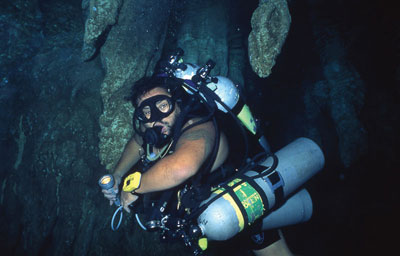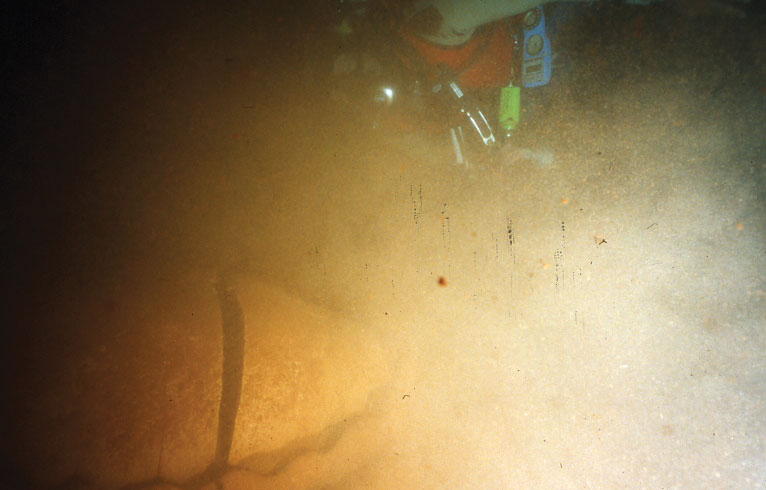Technical scuba divers generally have one need in common… they need breathing gas, and lots of it! This is where rebreathers offer them a huge advantage. Other benefits include reduced gas costs, less time pressure and stress, faster decompression, and less silting.
Gas Economy
I started my technical diving activities in cave diving. The distance we can explore a cave is directly tied to the amount of gas we can carry. The more breathing gas we have, the further we can go, and safely return (always an important consideration!). With open circuit (OC) scuba there are two ways to carry more gas: larger cylinders, or more of them. Once you move beyond carrying twin 120 cf tanks, going to a larger size becomes impractical.

So we carry more bottles, carrying them under our arms on our sides. These stage bottles allow us to go further. By the time I quit using OC scuba, I was routinely carrying four tanks as my “normal” configuration, and lugged as many as eight tanks and regulators on a single dive for some of my more extended explorations. This is also impractical, especially in tight cave passages. One rebreather can replace all of these.
We still need to carry bailout gas for emergencies, but with a rebreather you need much less equipment. As an example, in a three person team each diver carries one rebreather, and a single 104 cf bailout bottle. This configuration allows us to do the same dive that on OC scuba would require us to carry 936 cf of gas each! This is the equivalent of each diver carrying a dozen 80 cf cylinders!
Words & Photos by Jeff Bozanic
Reduced Gas Cost
Similar advantages are realized by deep divers. They also use lots of gas. The difference here is that the gas they use is expensive. Because they use helium to replace the nitrogen in air to avoid narcosis (more on this in a future column), their fills cost a lot more. When the cost of the decompression gas is included, it is not uncommon that a diver pays as much as $200 for fills for a single deep dive. Fills for the same dive in a rebreather will generally run about $5.

When installed in a rebreather, this single 22 cf (3L) cylinder can provide enough oxygen for a diver to stay at 300 fsw (or any other depth) for up to ten hours!
Instead of using 200 cf of gas on an OC dive, I generally use less than 10 cf on a rebreather. If fact, I have done three dives to depths of 250-300 fsw each on a single 19 cf cylinder before having to refill it. Even when the additional cost of the carbon dioxide absorbent is included, a dive rarely costs more than $15.
Time Pressure
OC divers carry a limited supply of breathing gas. This translates to a limited time they have at the bottom. The deeper you venture, the less time you have. If you encounter a problem, for example entanglement, you have to solve it quickly, or perish as you drown from running out of air. This can be very stressful even if nothing goes wrong, and is known as “time pressure.”
The other major advantage in deep diving is that a rebreather diver has lots of time before running out of gas. The rebreather only replaces the oxygen that is metabolically used by the diver. It does not matter if the depth is 30 fsw, or 330 fsw. A 19 cf oxygen cylinder lasts me about 10 hours at normal exertion levels, regardless of depth. If I have a problem at 300 fsw, I have lots of time to deal with it without running out of gas. Decompression is still required, but at least I am still around to do it!

Rebreathers allow technical divers to complete their required decompression stops much more quickly compared to OC divers, often saving an hour or more in decompression time.
Faster Decompression
Depending on the dive time and depth, divers still must decompress when using a rebreather. However, they have the ability to modify the oxygen content in the gas they are breathing. This allows them to increase the percentage of oxygen in what they are breathing, thus increasing the rate at which dissolved inert gas in eliminated from the body. By doing this, decompression times may be reduced by as much as two-thirds!
This has multiple benefits. Beside having to put up with less boredom, in some environments this is a distinct safety advantage. Divers do not get as chilled, possibly avoiding hypothermia. They have less exposure to waves, surge, and the possibility of currents carrying them off while they are under water and unable to surface. Finally, if overly inquisitive marine organisms are in the vicinity (think “circling hungry sharks!”), then they may exit the water sooner than they could if decompressing on OC scuba.
Less Silting
One of the issues technical divers face in enclosed environments is silt. Inside wrecks or caves, silt often covers everything; floors, walls, even the ceilings above you. The bubbles released by OC scuba systems often dislodge this silt, obscuring visibility.
I remember one cave in Hawaii. When we entered, we measured visibility at nearly 400 feet. On the way out, visibility had been reduced to just three inches! And that was due almost entirely to bubbles from out exhaled breath. Because closed circuit rebreathers are bubble-free during normal operation, this problem is largely eliminated.

Silt dislodged by exhaust bubbles can obscure visibility in caves and wrecks. Rebreathers can prevent this.
So as you can see, rebreathers provide great benefits to technical divers. This is why they were early adopters of the technology. But recalling the column in the last issue, rebreathers provide equally substantial benefits to active recreational divers as well. So regardless of the type of diving you do, you may want to poke your mask a little deeper into the rebreather world!
(For those who are interested, there is a lot of information about rebreathers available on www.rebreatherworld.com, or you can order a copy of Mastering Rebreathers directly from Jeff Bozanic at JBozanic@HQonline.net)
About the Author:
Jeff was certified as a NAUI Instructor in 1978, is certified to teach SCUBA diving for the NSS-CDS, NACD, IANTD, TDI, and NAUI. He is active in teaching cave diving, rebreather, nitrox, technical nitrox, and trimix diving courses. He has published extensively on diving education topics, with heavy emphasis on cave diving safety techniques. He has edited/reviewed many diving textbooks, and is the author of Mastering Rebreathers. He has served on several Boards of Directors in the scuba diving community, including as Chairman of the NSS-CDS and as Vice Chairman of NAUI, and as Treasurer on the AAUS Board. He has received the NAUI Outstanding and Continuing Service Awards; the Silver Wakulla, Abe Davis, Henry Nicholson, and International Cave Diving Awards for safe cave diving; the SSI Platinum Pro 5000 Award, and is a NAUI Hall of Honor inductee. In 2007 he was honored as the DAN/Rolex Diver of the Year. Jeff may be contacted at jeff@jeffbozanic.com.
